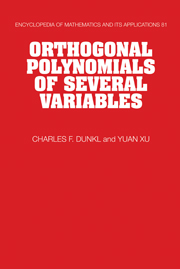Book contents
- Frontmatter
- Contents
- Preface
- 1 Background
- 2 Examples of Orthogonal Polynomials in Several Variables
- 3 General Properties of Orthogonal Polynomials in Several Variables
- 4 Root Systems and Coxeter groups
- 5 Spherical Harmonics Associated with Reflection Groups
- 6 Classical and Generalized Classical Orthogonal Polynomials
- 7 Summability of Orthogonal Expansions
- 8 Orthogonal Polynomials Associated with Symmetric Groups
- 9 Orthogonal Polynomials Associated with Octahedral Groups and Applications
- Bibliography
- Author index
- Symbol index
- Subject index
9 - Orthogonal Polynomials Associated with Octahedral Groups and Applications
Published online by Cambridge University Press: 17 December 2009
- Frontmatter
- Contents
- Preface
- 1 Background
- 2 Examples of Orthogonal Polynomials in Several Variables
- 3 General Properties of Orthogonal Polynomials in Several Variables
- 4 Root Systems and Coxeter groups
- 5 Spherical Harmonics Associated with Reflection Groups
- 6 Classical and Generalized Classical Orthogonal Polynomials
- 7 Summability of Orthogonal Expansions
- 8 Orthogonal Polynomials Associated with Symmetric Groups
- 9 Orthogonal Polynomials Associated with Octahedral Groups and Applications
- Bibliography
- Author index
- Symbol index
- Subject index
Summary
Introduction
Adjoining sign-changes to the symmetric group produces the hyperoctahedral group. Many of the techniques and results from the previous chapter can be adapted to this group by considering functions even in each variable. A second parameter k′ is associated to the class of sign-changes. The body of the chapter begins with a description of the differential–difference operators for these groups and their effect on polynomials of arbitrary parity (odd in some variables, even in the others). As with type A there is a fundamental set of first order commuting self-adjoint operators and their eigenfunctions are expressed in terms of nonsymmetric Jack polynomials. The normalizing constant for the Hermite polynomials, that is, the Macdonald–Mehta–Selberg integral, is computed by use of a recurrence relation and analytic function techniques. There is a generalization of binomial coefficients for nonsymmetric Jack polynomials which can be used for the calculation of Hermite polynomials. Although no closed form is as yet available for these coefficients we present an algorithmic scheme for obtaining specific desired values (by symbolic computation). Calogero and Sutherland were the first to study non trivial examples of many-body quantum models and show their complete integrability. These systems concern identical particles in a one dimensional space, the line or the circle. The models have been extended to allow nonsymmetric wave functions by allowing the exchange of spins between two particles. There is a concise description of the Schrodinger equations of the models and the construction of wave functions and commuting operators, using the type A and B operators. The chapter concludes with notes on the research literature in current mathematics and physics journals.
- Type
- Chapter
- Information
- Orthogonal Polynomials of Several Variables , pp. 337 - 371Publisher: Cambridge University PressPrint publication year: 2001

